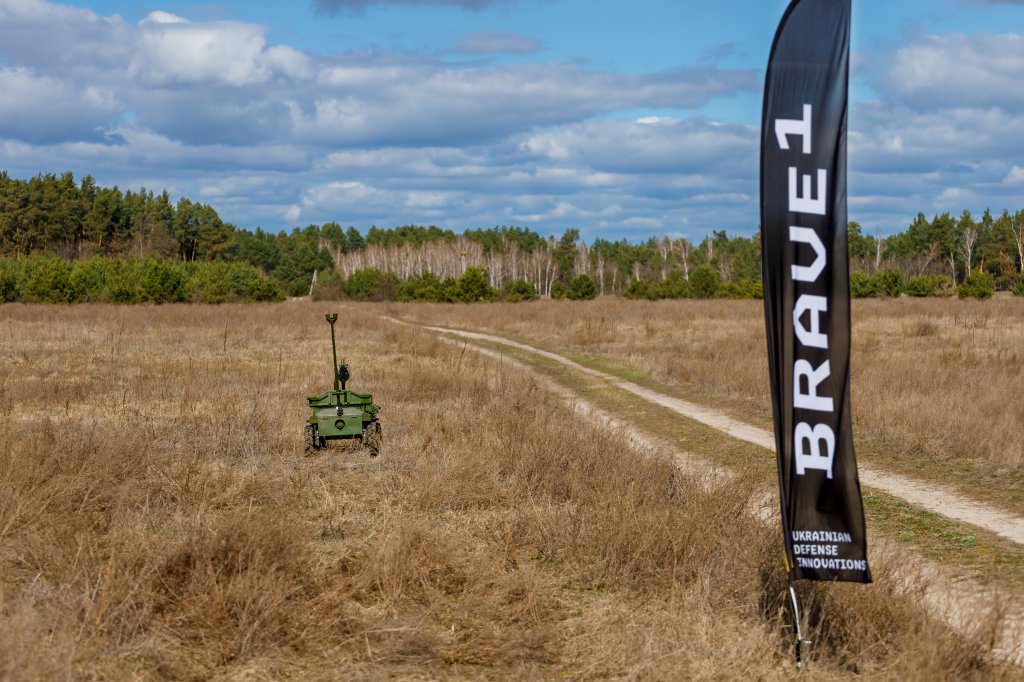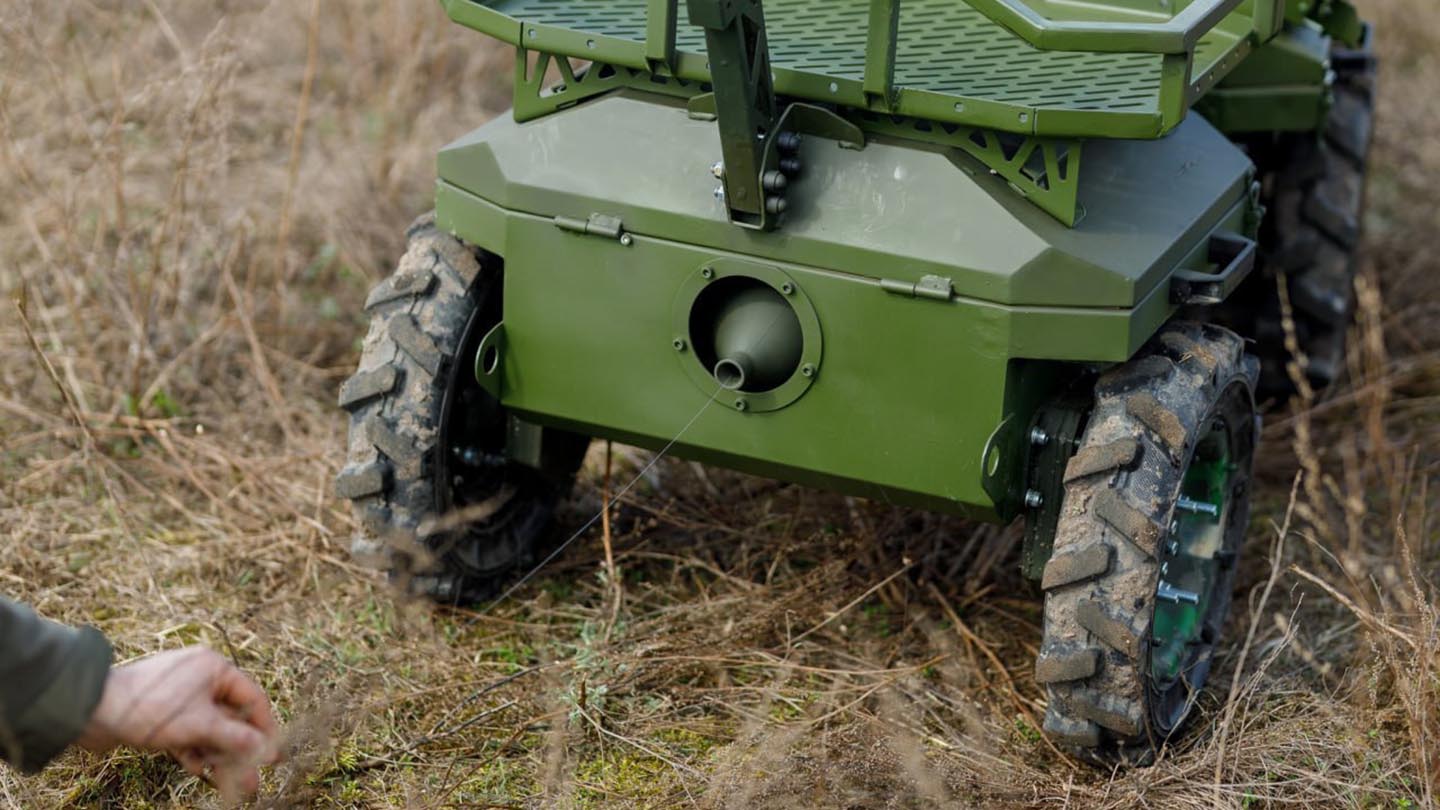Inspired by the success of fiber optic cables on first-person view (FPV) drones, Ukraine is beginning to test them on uncrewed ground vehicles (UGV). Earlier this week, Ukraine’s Brave1 defense technology incubator tested seven different models.
Both Ukraine and Russia have been increasingly using hard-wired fiber optics for control links for FPV aerial drones. That’s because control links cannot be jammed by electronic warfare equipment. In addition, the links won’t be degraded when operating low over the ground, among obstacles and in rough terrain because they are not dependent on line-of-sight connectivity requirements found in radio frequency systems. You can read more about the development of this technique in our original story here.
“We are very interested in the implementation of fiber optic so that our [UGVs] can operate at longer distances and help us destroy the enemy even more effectively,” Capt. Alexander Jabchanka, the Head of Robotic Systems Service of the Vovki Da Vinci Battalion, said on Facebook. Jabchanaka was on hand for the Brave1 test event, which also included updated FPV drones.



Ground drones with fiber optic cables have yet to be fielded by Ukraine, Brave1 told us, adding that the test results were promising.
The technology of optic-fiber-controlled UGVs “is still in the early stages, but we have managed to identify some promising solutions,” Brave1 stated. “While not yet ready for mass deployment in the Armed Forces of Ukraine, it holds the potential to be a game-changer in certain well-calculated scenarios.”
We asked Brave1 to elaborate on those solutions and scenarios and will update this story with any pertinent information provided.
Most UGVs already in service with Ukraine are used for the transportation of equipment, supplies, the wounded and weapons, said the director of the procurement department of Ukraine’s Ministry of Defense, Gleb Kanevsky. They are also used for mine laying and kinetic tasks, such as employing bolted-on machine guns.

At the moment, Ukraine is looking to use fiber-optic-controlled variants for kamikaze strikes and high-risk combat operations and not for logistics.
“Logistics tasks involving the same or different robots moving along the same route in one direction and back are less optimal due to the potential for fiber-optic cables to interfere with one another or objects on the ground,” Brave1 told us.
One of the biggest reasons UGVs have yet to be used more widely are the challenges with the command links over uneven or urban terrain, Kanevsky told the Ukrainian Ekonomichna Pravda news outlet. That is a problem Brave1 is looking to solve with fiber optics.
“The platform must have reliable communication because it can be easily lost due to terrain distortions or other obstacles,” Kanevsky noted. “The robot must be cross-country, that is, not get stuck in grass, snow, sand, and mud.”
While fiber optic cables offer an advantage in operating when there is no or limited line-of-site, one challenge that has to be overcome is the cables getting tangled up on rocks, vegetation and other obstacles. It is unclear how recent testing addressed this issue.
Radio-controlled UGVs began to appear in combat a little more than two years ago. Video emerged in February of that year showing a Russian variant in service near Svyatovo. The wheeled vehicle featured a remote turret with both 7.62mm and 12.7mm machine guns. Later that year, Ukraine introduced its own combat UGV, called the Liut, equipped with a 7.62mm machine gun. You can see the Russian UGV in the following video.
The advancement of these vehicles has reached the point where Ukraine carried out what is described as the first all-drone assault last December, using FPVs and UGVs to attack Russians near the village of Lyptsi in the Kharkiv region.
Though Ukraine is still learning how and when to use UGVs, its army will receive 15,000 this year, according to Kanevsky. That’s a figure that pales in comparison to the more than one million aerial drones Ukraine will obtain. While a number of UGV variants have already been fielded, the use of these systems is still in the early stages, Kanevsky stated.
Though Ukraine has yet to field UGVs with fiber optic cables, it anticipated this would be the case eventuality. Back in February, Ukraine’s Unmanned Systems Forces introduced universal fiber-optic navigation modules, named Shovkopryad (“Silkworm”), designed for integration into air, ground, and maritime drones. Having universal modules would reduce the cost and timeline for using fiber optics on ground drones because they would be interoperable, offering cost reduction at scale.

Brave1 claims the testing “proved the viability of optic-fiber-controlled UGVs in specific scenarios.”
“Our next step involves developing the tactics for their application,” Brave1 explained to us. “Our team is currently working on this in collaboration.”
The U.S. military too has been developing a wide range of UGVs, which you can read more about in stories found here. The lessons learned from Ukraine’s use of fiber optics on these vehicles will no doubt be noted by the Pentagon.
Should these tests lead to overcoming the problem of controlling UGVs amongst heavy Russian jamming and difficult radio frequency connectivity that limit UGV operations, fiber optic links could quickly become widespread on the battlefield, just as they have with aerial drones. It could also be a major catalyst in speeding up the use of UGVs in combat as a whole.
Contact the author: howard@thewarzone.com
